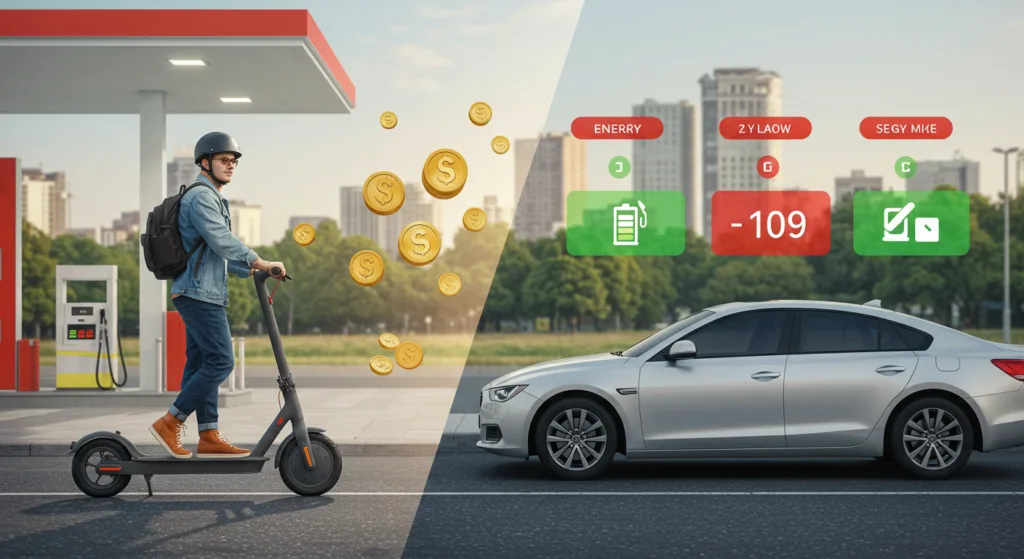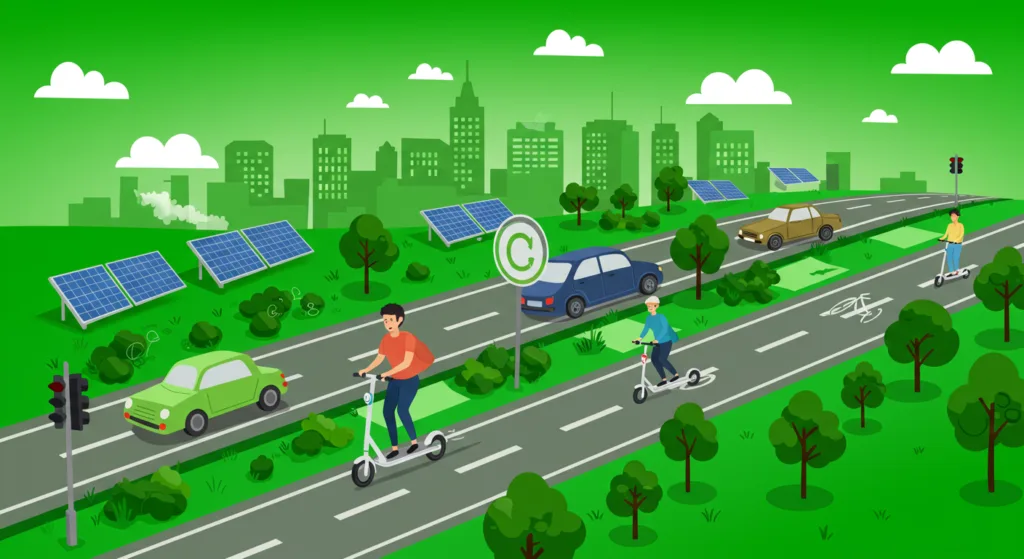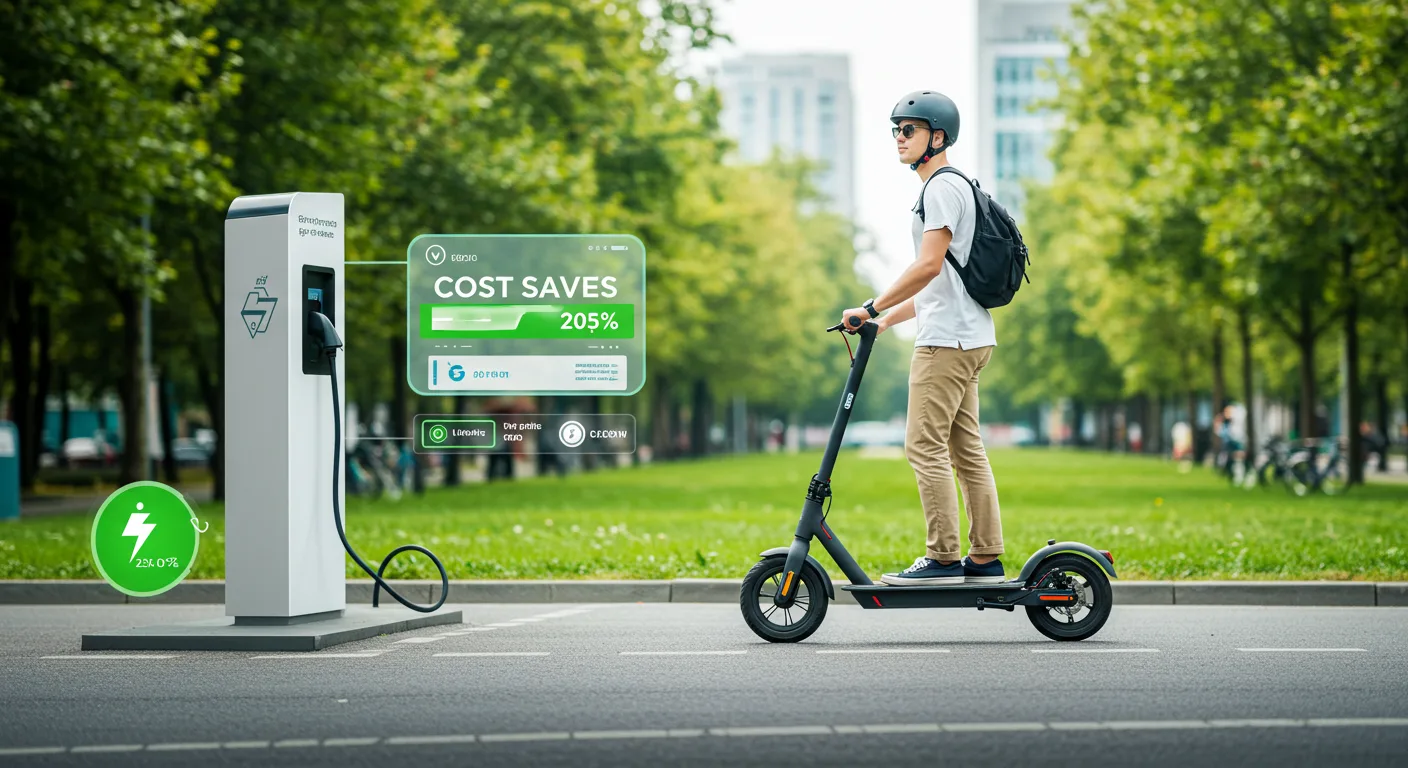The True Cost of Owning an Electric Scooter

Many people are considering electric scooters as a cost-effective and convenient transportation option. But are they really affordable in the long run? Let’s break down the real cost of owning an e-scooter, from the initial purchase price to maintenance and savings compared to cars.
How Much Do Electric Scooters Cost Upfront?
The initial cost of an electric scooter depends on factors like range, speed, battery capacity, and build quality. Prices vary widely, so choosing the right model depends on your needs.
Price Ranges for Electric Scooters:
- Entry-Level (Basic Commuter Models) – $300 to $600
- Range: 10–15 miles per charge
- Top Speed: 12–15 mph
- Suitable for short commutes and smooth city roads
- Mid-Range (Better Performance & Features) – $600 to $1,200
- Range: 20–35 miles per charge
- Top Speed: 15–25 mph
- Includes better suspension, lights, and regenerative braking
- Premium & High-Performance Models – $1,500 to $4,000+
- Range: 40–80 miles per charge
- Top Speed: 30–50 mph
- Designed for longer commutes, higher speeds, and off-road terrain
Compared to electric cars, where even a budget e-car like the Chevy Bolt EUV costs around $27,000, an e-scooter is significantly cheaper upfront. For many urban commuters, an electric scooter can replace daily short car trips, saving thousands in initial costs.
What Are the Ongoing Maintenance and Charging Expenses?
One of the biggest advantages of electric scooters over electric vehicles (EVs) is their low maintenance and charging costs. Unlike e-cars that require charging stations, e-scooters can be charged at home using a standard outlet.
Charging Costs:
- The average e-scooter battery capacity is 250Wh to 1,500Wh (0.25–1.5 kWh).
- Charging an electric scooter costs between $0.15 and $0.50 per full charge, depending on electricity rates.
- With daily use, monthly charging costs rarely exceed $5 to $10, much lower than fueling a gasoline car or charging an electric car, which can cost $30–$60 per month for home charging.
Maintenance Costs:
- Tires: Most solid rubber tires last 2,000–3,000 miles, while pneumatic tires need replacement every 1,000–2,000 miles ($30–$60 per set).
- Brakes: Disc brakes need adjustment every 500–1,000 miles, costing $20–$50 per service.
- Battery Replacement: A high-quality lithium-ion battery lasts 500–1,000 charge cycles (~2–4 years of regular use). Replacing a battery can cost $150–$600, but most users don’t need to replace it frequently.
Unlike electric cars, which may require tire replacements (~$500–$1,000) and battery replacements ($5,000–$10,000) over time, e-scooters are much cheaper to maintain. Even compared to a traditional gas-powered vehicle, where annual maintenance costs $500–$1,200, an e-scooter is a fraction of the expense.
Do E-Scooters Really Save You Money Compared to Cars?
Owning an electric scooter isn’t just about the purchase price—it’s about how much you save over time. Let’s compare the total cost of ownership for e-scooters vs. cars (gas & electric).
Annual Cost Breakdown:
| Expense | Electric Scooter | Gas Car (30 MPG) | Electric Car (EV) |
|---|---|---|---|
| Purchase Cost (Avg.) | $600–$1,500 | $25,000+ | $35,000+ |
| Fuel/Electricity | $50 per year | $1,500+ | $400–$700 |
| Insurance | $0 (optional) | $1,200+ | $800–$1,500 |
| Registration & Taxes | $0–$50 (varies) | $400–$1,000 | $200–$500 |
| Maintenance | $100–$300 | $500–$1,200 | $300–$800 |
| Total Yearly Cost | $150–$350 | $3,500+ | $1,700+ |
Key Savings Highlights:
- No Gas Needed: With gas prices fluctuating between $3.50 and $5 per gallon, an e-scooter eliminates fuel expenses entirely.
- No Insurance Required: Unlike cars, e-scooter insurance is optional (if required, it costs around $100 per year).
- No Expensive Parking Fees: In cities, parking can cost $2–$10 per hour or $200–$500 per month. E-scooters don’t require parking permits or garages.
- Lower Maintenance Costs: A well-maintained e-scooter costs less than $200 per year, while gas and electric cars cost 5x to 10x more in upkeep.
For urban commuters and students, switching to an electric scooter could mean saving $3,000+ per year compared to owning a car. While an e-car is a great long-term investment, an e-scooter is a more cost-effective choice for short-distance travel.
🚀 Tip:
When choosing an electric scooter, consider battery range, durability, and road adaptability to ensure it meets your commuting needs. Investing in a mid-range or premium model can save you more in the long run by reducing maintenance costs and improving ride comfort.
Are Electric Scooters a Practical Choice for Daily Commuting?

With rising fuel prices and growing traffic congestion, many people are turning to electric scooters as a daily commuting solution. But are they practical enough to replace cars or public transport? Let’s break it down by looking at range, road conditions, and long-term reliability.
How Far Can an E-Scooter Travel on a Single Charge?
Range is one of the most important factors when choosing an electric scooter for daily commuting. How far you can travel depends on the battery capacity, rider weight, terrain, and weather conditions.
Typical E-Scooter Ranges by Category:
- Entry-Level Commuter Scooters (250Wh – 350Wh battery)
- Range: 10–15 miles
- Best For: Short city commutes, last-mile travel
- Example: Xiaomi Mi 3 Lite (~13 miles per charge)
- Mid-Range Scooters (500Wh – 800Wh battery)
- Range: 20–35 miles
- Best For: Medium-distance commuting, mixed urban use
- Example: Segway Ninebot Max (~30 miles per charge)
- High-Performance Scooters (1000Wh – 2000Wh battery)
- Range: 40–80 miles
- Best For: Long commutes, replacing a car
- Example: Dualtron Thunder (~75 miles per charge)
By comparison, electric cars (EVs) like the Nissan Leaf offer 150–250 miles per charge, but cost significantly more. If your daily commute is within 5–20 miles round trip, an e-scooter can easily handle your travel needs without requiring frequent recharges.
Can Electric Scooters Handle Different Road Conditions?
One major concern for riders is whether e-scooters can perform well on different types of roads. Unlike electric cars, which have powerful shock absorption and all-terrain tires, e-scooters need to be chosen carefully based on the terrain they will encounter.
How E-Scooters Handle Different Road Conditions:
- Smooth Pavement & City Streets
- Most commuter scooters work well on asphalt and concrete roads.
- Models with 8.5-inch pneumatic tires provide better shock absorption.
- Example: Xiaomi Mi Electric Scooter Pro 2
- Rough & Uneven Roads (Cobblestones, Brick Streets)
- Larger wheels (10–11 inches) and dual suspension improve comfort.
- E-scooters with pneumatic or tubeless tires handle bumps better.
- Example: Apollo Phantom (with front & rear suspension).
- Hills & Steep Inclines
- Entry-level scooters struggle on inclines over 10–15% grade.
- Powerful motors (500W–1000W) and dual-motor models handle slopes better.
- Example: Kaabo Wolf Warrior 11 (climbs up to 30% grades).
- Rain & Wet Roads
- Some e-scooters have IPX water resistance ratings (e.g., IP54 for light rain).
- Avoid scooters with poor grip tires on wet surfaces.
- Example: Segway Ninebot Max G30 (IPX5 water resistance).
Unlike electric vehicles (EVs) that perform well in all weather conditions, e-scooters require a more careful selection based on your environment. If you live in an area with hills or rough roads, choosing the right tires and motor power is essential for a safe ride.
Are E-Scooters Reliable for Long-Term Use?
Durability is a key factor when considering an e-scooter for daily commuting. Unlike electric cars, which are built to last 10–15 years, e-scooters have a shorter lifespan but can still be reliable for 3–5 years with proper care.
Factors That Impact E-Scooter Longevity:
- Battery Life
- A typical lithium-ion battery lasts 500–1,000 charge cycles (2–4 years).
- Charging correctly (not overcharging or fully depleting) extends battery health.
- Frame & Build Quality
- Aluminum alloy frames last longer than plastic-heavy models.
- Foldable mechanisms can wear out with frequent use—look for reinforced joints.
- Motor & Electronic Components
- Brushless motors are durable and require minimal maintenance.
- Waterproof controllers & connectors help prevent electrical failures.
Average Lifespan of an E-Scooter by Quality Level:
| Scooter Type | Expected Lifespan | Maintenance Needs |
|---|---|---|
| Budget Scooters (<$500) | 1–2 years | Frequent repairs |
| Mid-Range Scooters ($600–$1,500) | 3–4 years | Moderate upkeep |
| Premium Scooters ($1,500+) | 4–6 years | Low maintenance |
Compared to electric cars, which require battery replacements after 8–10 years, e-scooters have a shorter lifespan but significantly lower replacement costs. A $1,000 premium e-scooter can last 4+ years, making it a practical and affordable commuting option for city dwellers.
💡 Quote:
“The future of urban mobility is electric, efficient, and eco-friendly.” – Anonymous
Embrace the shift to electric scooters and experience a smarter, greener, and cost-effective way to navigate the city.
Environmental and Lifestyle Benefits of Electric Scooters

Electric scooters are more than just a convenient and cost-effective mode of transport—they also offer significant environmental and health benefits. As cities push toward sustainable urban mobility, e-scooters are emerging as a cleaner alternative to traditional vehicles. But how much of an impact do they really have? Let’s explore their role in reducing carbon emissions, replacing public transport, and promoting a healthier lifestyle.
How Do Electric Scooters Reduce Your Carbon Footprint?
One of the biggest advantages of electric scooters is their ability to reduce CO₂ emissions and reliance on fossil fuels. Unlike gas-powered cars, which contribute to urban air pollution and greenhouse gas emissions, e-scooters run on electricity, making them a cleaner option for daily commuting.
Key Ways E-Scooters Help the Environment:
- Zero Tailpipe Emissions:
- Gas-powered vehicles emit an average of 4.6 metric tons of CO₂ per year (EPA), while electric scooters produce zero direct emissions.
- Lower Energy Consumption:
- E-scooters use only 1.2 kWh per 100 km, compared to an electric car (EV) which consumes 15–20 kWh per 100 km.
- This means that e-scooters require 10–15 times less energy than electric cars for the same distance.
- Reduced Traffic Congestion:
- According to the Texas A&M Transportation Institute, urban traffic congestion wastes 3.3 billion gallons of fuel per year in the U.S. alone.
- By replacing short car trips with e-scooters, cities can significantly cut fuel consumption and CO₂ emissions.
- Integration with Renewable Energy:
- If charged using solar or wind energy, e-scooters can become 100% carbon neutral.
- Some public e-scooter sharing programs are already using renewable energy for charging stations.
While electric cars (EVs) are a great alternative to gasoline vehicles, e-scooters require even fewer resources to produce, charge, and maintain, making them an even greener choice for urban transport.
Are E-Scooters a Good Alternative to Public Transport?
Public transport plays a key role in reducing car dependency, but in many cities, it still has limitations like long wait times, overcrowding, and last-mile connectivity issues. Electric scooters offer a flexible, fast, and affordable alternative for short-distance travel.
Comparing E-Scooters and Public Transport:
| Factor | E-Scooter | Bus/Train |
|---|---|---|
| Speed | 15–25 mph (depends on model) | 10–50 mph (but includes stops & delays) |
| Cost per Trip | $0.15–$0.50 (charging cost) | $2–$5 per ride |
| Waiting Time | None – Ride anytime | 5–20 min depending on schedule |
| Last-Mile Travel | Direct door-to-door | May require extra walking or transit |
| Eco-Friendliness | Zero emissions | Varies – electric buses are greener |
Why E-Scooters Are a Strong Alternative:
- No Waiting Time: Unlike buses or trains, you don’t need to wait for an e-scooter. Just hop on and go.
- More Direct Routes: Public transport often requires multiple transfers, while an e-scooter lets you travel point to point without detours.
- Lower Cost Over Time: A personal e-scooter can replace daily transit fares, saving commuters $1,200+ per year in cities like New York, London, or Paris.
- Reduced Overcrowding: Many urban transit systems struggle with overcrowding, especially during rush hours. E-scooters provide an independent and stress-free commuting option.
While public transport remains essential for long distances, e-scooters are a practical, low-cost alternative for short commutes under 5–10 miles.
Can Riding an E-Scooter Improve Your Health and Fitness?
While e-scooters are motorized, they still offer surprising health benefits, especially when compared to sitting in a car or on public transport. Riding an e-scooter engages core muscles, improves balance, and encourages outdoor movement, which can lead to better overall health.
Health Benefits of Riding an E-Scooter:
- Engages Core & Leg Muscles
- Unlike driving a car or taking a bus, riding a scooter requires constant balancing, which strengthens your core, legs, and stabilizing muscles.
- Encourages More Outdoor Activity
- E-scooter riders tend to walk more before and after their ride, increasing daily step counts.
- Exposure to fresh air and sunlight boosts vitamin D levels and reduces stress.
- Improves Coordination & Reflexes
- Navigating city streets requires quick reflexes and spatial awareness, which improves overall motor skills.
- Reduces Sedentary Lifestyle Risks
- According to the WHO, physical inactivity is linked to increased risks of heart disease, obesity, and diabetes.
- E-scooters encourage more active transportation, reducing prolonged sitting time.
While e-scooters don’t replace a full workout, they do contribute to an active lifestyle by promoting movement and reducing time spent sitting in traffic or on crowded trains.
Switching to an electric scooter is a smart, eco-friendly, and cost-effective way to commute. From saving money to reducing your carbon footprint, e-scooters offer a practical alternative to cars and public transport.
⏰ Reminder:
✅ Charge your e-scooter overnight for a smooth, worry-free commute.
✅ Wear a helmet and follow local e-scooter regulations for safe riding.
✅ Share this article on social media to help others discover the benefits of electric scooters! 🚀♻️
If you found this guide helpful, share it on social media to help others discover the benefits of riding an electric scooter! 🚀♻️



